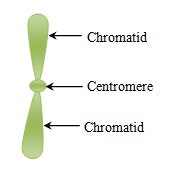Chromosomes mean ‘coloured body’. Chromosomes are thread like bodies which are present in the nucleus of a cell and which becomes visible only during cell division. Chromosomes contain hereditary information of the cell. Chromosomes are made up of DNA (Deoxyribo Nucleic Acid which is a double stranded, long, linear and helical structure) and proteins. But DNA is its most important component.
Chromosomes are not visible clearly under microscope in the interphase stage of cell growth because these are present in the form of very long, slender and thread like structures called chromatin in the nucleus. The chromatin fibers condense during the metaphase stage of the cell division to form short, thick and rod like structures called chromosomes. These chromosomes can now be seen under the microscope. The chromosomes bear genes which are the units of hereditary information.
Structure of Chromosome

Each chromosome consists of two strands called chromatids. The two chromatids of a chromosome are joined together at a point called centromere. The chromatids can separate from each other during cell division to form new chromosomes.
Test Your Understanding and Answer These Questions:
- What are chromosomes?
- Discuss the structure of chromosome.
- What are the components of a chromosome?
- Define homologous chromosomes.
- During which stage of cell division can chromosomes be seen?
